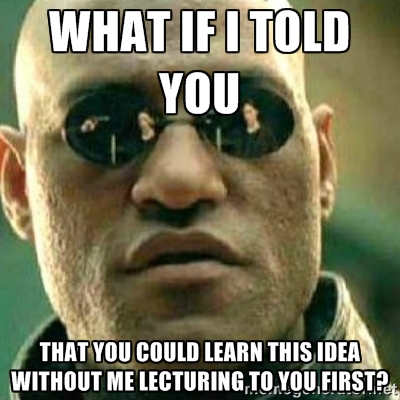
"Feel the confident self-efficacy flow through you, you will"
So, loyal readers, if you’ve gotten this far in Robert Talbert’s blog series in “Casting Out Nines” about his flipped calculus class, you’ve got a sense of his larger motivation — he wants his students to not just learn math, but to develop as independent learners — as well as the theoretical commitments of “self-regulated learning” (SRL) that informs his pedagogy. Of course, it’s unreasonable to expect a novice in any new area of inquiry to figure out everything on her own outside of class without assistance. We teachers are still necessary, after all.
Talbert’s approach to scaffolding self-regulated learning, the notion of “Guided Practice,” is a recurrent concept in the literature on SRL. While the burden for deploying the learned content shifts from teacher to student, the teacher provides guidance in the form of objectives and suggested alternative approaches that enable the student to take primary ownership of the learning without losing direction (and therefore confidence and a sense of self-efficiacy).
Talbert also considers the tricky matter of assessment: how can we know if students are becoming more self-regulated learners as a result of flipped class pedagogy?
___________________________
The inverted calculus course: Using Guided Practice to build self-regulation
March 4, 2014, 2:59 pm
By Robert Talbert
This post continues the series of posts about the inverted/flipped calculus class that I taught in the Fall. In the previous post, I described the theoretical framework for the design of this course: self-regulated learning, as formulated by Paul Pintrich. In this post, I want to get into some of the design detail of how we (myself, and my colleague Marcia Frobish who also taught a flipped section of calculus) tried to build self-regulated learning into the course structure itself.
We said last time that self-regulated learning is marked by four distinct kinds of behavior:
- Self-regulating learners are an active participants in the learning process.
- Self-regulating learners can, and do, monitor and control aspects of their cognition, motivation, and learning behaviors.
- Self-regulating learners have criteria against which they can judge whether their current learning status is sufficient or whether more learning needs to take place. (And then they take initiative to close the gap, if it exists, because of #2.)
- Self-regulating learners select learning activities to serve as mediators between their learning goals and their own personal environment and circumstances.
This is really the vision that I have for each one of my students – that they would eventually become this kind of learner, and that when they take a class with me, the class moves them incrementally toward being a self-regulated learner. In fact I’ve come to believe that the end goal of all of higher education is to produce self-regulating learners.
I also said last time that the inverted/flipped classroom is an ideal setting for working on self-regulated learning behaviors because of its emphasis on independent acquisition of new content prior to class. While I think the real magic of the flipped classroom takes place in class, when students are working together on difficult problem solving tasks, it’s in the pre-class phase of the flipped design that the best chance for developing self-regulation happens. So one of the main design goals of the course was to build a recurring form of pre-class activity that not only leads students through new content but also explicitly builds basic skills pertaining to self-regulated learning. That role was filled by what I call Guided Practice.
Continue reading →



